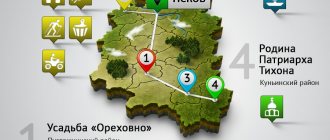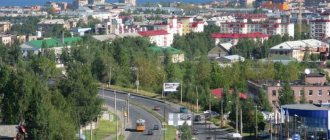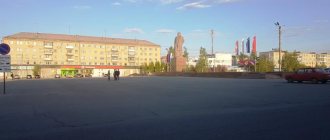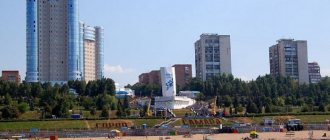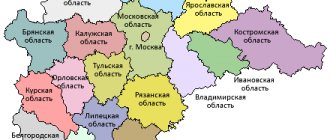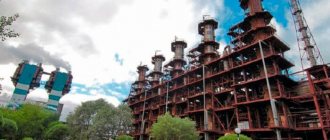A city of over a million people, a modern economic and cultural center of the Urals, the capital of the Republic of Bashkortostan - all this is Ufa . A contradictory and attractive city: on the one hand, there are many industrial facilities that provide jobs for hundreds of thousands of citizens and fill the city budget, on the other hand, there is a deplorable ecological state of the environment due to the huge amount of emissions.
On the one hand, a small percentage of residents are of retirement age, which indicates a high mortality rate in middle years. On the other hand, there is a positive indicator of natural population growth, which indicates not only a good birth rate, but also favorable conditions and a sufficient level of security for citizens.
General information about Ufa
In 2014, Ufa residents celebrated 440 years since the founding of their small homeland. It is 1574 that is considered to be the starting point of the city’s history. Then a fortress was built, which became a reliable protection for the inhabitants from the raids of nomads and the encroachments of conquerors. It is noteworthy that Ufa has never submitted to anyone in its history. Residents withstood two planned assaults during the Pugachev uprising and a siege that lasted 4 months. Now they proudly call their city invincible.
However, not only the past is worthy of attention. The geographical location and wealth of natural resources shape the modern appearance of the city. The forests are rich in wildlife and attract hunters and researchers.
The hilly plains in winter are a godsend for skiers. There are also water resources - the Dema, Ufa and navigable Belaya rivers. The city stretches for 53 km in the direction from north to south, and takes third place in terms of length in Russia. Its area of 707.9 km2 allows it to rank seventh in size after the capital and other Russian cities.
The infrastructure is diverse and developed. Transport arteries are represented by railways, roads, rivers, airways, and pipelines. They connect Siberia and the Urals with the European cities of Russia. From the Ufa airport you can get to many countries in Europe and Asia.
Ecological, climatic conditions and population of Ufa
Features of the Ufa climate:
- constant high humidity;
- warm summer;
- moderately cold, but long and snowy winter, which begins in November and ends in April.
Presentation film about Ufa (part 1):
Features of Ufa ecology in 2021-2022:
- the city ranks 9th among the most polluted cities in the Russian Federation;
- colossal gas pollution: there is smog all year round, which is formed from enterprises and cars;
- wastewater is discharged into city rivers;
- long-outdated wastewater treatment facilities;
- lack of a plant for processing solid household and industrial waste, which the city has needed for a very long time.
Peculiarities of the population of a city with a population of one million:
- the prevailing number of women;
- stable natural population growth;
- more than 65% of residents are citizens of working age;
- less than 8% are people of retirement age;
- multinationality (but the bulk are Russians, Bashkirs and Tatars);
- high population density in the city and suburbs.
Presentation film about Ufa (part 2):
Climate in Ufa
The territory of Bashkiria is characterized by long winters, when the air temperature drops to -10, -15°C, and warm summers with average temperatures of + 15, +20 °C. The climate is humid, continental. An average of 600 mm of precipitation falls here annually.
In summer, warm Atlantic air currents dominate over Ufa. They warm up the air. The maximum temperature of the warmest month was reached in 1952 and was +38.6 °C. Although this is rare, the average temperature in July is +20+30 °C. Summer lasts 90-100 days, in mountainous areas - 60 days. In summer, the rains become torrential in nature. In the vicinity of squally winds, gusts of which reach 30 m/s, stronger thunderstorms are formed.
In winter, the influence of an anticyclone from Asia is felt in Bashkiria. In January, temperatures drop to 20-30 °C. The average for the coldest month is -16-18°C. The minimum temperature was recorded at -48 °C. Cooling is usually observed already at the end of October. Snow falls and remains until mid-April. In March its layer is the highest. In recent years, the area has become characterized by abnormally warm winters. Ecologists became interested in this phenomenon.
Spring and autumn are short. Usually there is an alternation of warm days with frosts. In spring they can be observed until the beginning of June; in autumn, the first frosts occur in mid-September.
Geographical information
The city is located in the interfluve of the Belaya River and its tributary, the Ufa.
The length of the settlement is fifty-four kilometers, the width is thirty.
The climate is temperate continental.
The minimum recorded temperature is minus forty-nine degrees, the maximum is plus thirty-nine. Average – plus four.
The distance to the capital of the Russian Federation along a direct road is one thousand three hundred and forty kilometers.
Ecology of Ufa
The state of the city's environmental performance has been causing concern for several decades. The developed industrial segment pollutes the air, soil, water every day and has a negative impact on the health of both people and animals. In the environmental rating of 2012, the republic took 61st place. For comparison, at the same time, in terms of economic indicators, it is in 14th place.
According to statistics, there is an acute problem with the processing of solid waste. Moreover, from 140 to 200 tons of waste are stored in the city area per year, and about 300 more are transported to the local landfill. Environmentalists and the public have repeatedly discussed with local authorities the need for a city plant that would process waste. The processed raw materials would be suitable for industrial use, thus the plant's activities would be self-sustaining or even profitable. However, there is no movement in this direction yet.
Water resources are heavily polluted. This applies to all local bodies of water, including rivers. No improvements have been observed yet.
The air masses are filled daily with products from the oil refining and chemical industries. According to the chief ecologist, the smell and concentration of aromatic hydrocarbons from the production of factories are an integral part of the atmosphere. This phenomenon can be compared with a bouquet of chemical aromas in the city of Salavat. Smog often accumulates over the city; in some areas its concentration exceeds the norm several times.
Citizens are forced to suffocate and react with the appearance of new allergies. And only a strong wind significantly reduces smoke, filling the air with freshness.
Based on the results of a survey of citizens, the information department of the mayor’s office on the environmental situation in Ufa published the following data:
- Air comes first in terms of pollution levels;
- further in the ranking is the state of water in rivers;
- in third place was the increase in the number of vehicles in the city (concerns are caused by noise levels and the amount of exhaust gases);
- in last place is a large amount of solid household waste.
Among the problems, more mundane ones are also voiced. For example, summer residents often find spontaneous garbage dumps in forest belts.
The situation is especially critical in coastal flat areas. After all, after rain, various chemicals flow into the river stream, and they also saturate the top layer of soil. The administration, as a rule, takes measures in such cases, but it happens that the damage caused to nature cannot be corrected.
UFA
Ufa. Panorama of the city. Photo by O. Menkov
UFA, a city in Russia, the capital of the Republic of Bashkortostan, the center of the urban district of the same name. Population 1124.2 thousand people (2019). Located on the river. Belaya (port), at the confluence of the Ufa and Dema rivers. Large transport hub. International Airport.
Story
A number of settlements are associated with the settlements that preceded Ufa (including Ufa-II, area approximately 2 hectares, with finds from the 4th/5th to 14th centuries), elite burials of the 5th–7th centuries. Turbaslinskaya culture. A number of researchers connect the medieval city with the settlement of Ufa-II, designated as Pascherti on the map of the Pitsigani brothers (1367), in the Catalan Atlas (1375), and later also on the map of G. Mercator (1554). Mentioned among the largest cities of the Golden Horde by an Arab author of the 14th century, it is also identified with it. Ibn Khaldun and others, Bashgird (Bashkort). In the 16th century on the site of modern U. there was Imen-kala (“oak city”) - the headquarters of the governor of the biys of the Nogai Horde in Bashkiria.
According to the most substantiated version, Uzbekistan was built as a Russian fortress in 1586 under the leadership of M. A. Nagoy (total area 1.2 hectares, wall length 440 m) (since the 18th century there has been a hypothesis about the foundation of Uzbekistan in 1574). Since the same year, the center of the county. From the end of the 16th century. used as a place of political exile. An important trading center on the way from the European part of the country to Siberia. In the mid-1660s - 1670s. A new fortress was erected, covering the entire territory of the city (the length of the walls is 2.4 km). District city of the Kazan province (1708–19), district city and center of the Ufa province, which was part of the Kazan province (1719–28, 1733–40) and the Orenburg province (1744–1781/82) and was directly subordinate to the Senate (1728–33) , 1740–44). In 1734–36, the seat of the head of the Orenburg expedition. In 1759, a significant part of the city was destroyed by fire. In November/December 1773 – March/April 1774 it withstood the blockade, as well as the assaults [12/23/1773(3/1/1774) and 1/25/1774] by the rebels during the Pugachev uprising of 1773–75. Center of the Ufa governorate (1781/82–1796), district city (1796–1802) and administrative center (1802–65) of the Orenburg province, center of the Ufa province (1865–1922). From the 2nd half of the 19th century. industry developed. In 1870, a permanent passenger steamship service began along the river. Belaya, traffic was opened on the railway lines Kinel - Ufa (1888) and Ufa - Zlatoust (1890).
In August 1917, the 2nd All-Bashkir Kurultai was held in Uzbekistan. Soviet power was established on October 26 (November 8), 1917. After the start of the 1918 Czechoslovak Corps, it came under the control of the Committee of Members of the Constituent Assembly on July 5, 1918. On September 8–23, 1918, the Ufa State Meeting of representatives of anti-Bolshevik governments took place in the city. In September - October 1918, seat of the Ufa Directory. On December 31, 1918 it was occupied by units of the Red Army, on March 13, 1919 – by white troops, on June 9, 1919 – again by the Red Army. Since 1922, the capital of the Bashkir Autonomous Soviet Socialist Republic (in 1990–92 the Bashkir SSR, since 1992 the Republic of Bashkortostan), the center of the canton (1922–30) and the region (since 1930). In the 1920s–30s. A number of large industrial enterprises were built, including an engine plant (now PO) and an oil refinery (1937; now part of the Bashneft company). Traffic was opened along the railway line Dema (now within the boundaries of Ukraine) - Ishimbayevo (1934). During the Great Patriotic War, in 1941–42, St. was evacuated to Ukraine from the western regions of the country. 40 industrial enterprises, the Presidium and most of the institutes of the Academy of Sciences of the Ukrainian SSR, a number of scientific institutions of the Academy of Sciences of the USSR and universities, the Kiev Academic Opera and Ballet Theater, etc. In 1944–56, the Stalinsky district of Uzbekistan was separated into the independent city of Chernikovsk; in 1955 traffic was opened on the Chernikovka – Zagorodnaya railway line. In 1952–53 the center of the Ufa region. In the 2nd half of the 20th century. developed as a large industrial center. Since 2006 the center of the urban district. City of Labor Valor (2020).
Architecture
The center of Uzbekistan is built up with rectangular blocks according to a regular plan (1803, architect W. Geste; revised in 1817–19). The following have been preserved: the Intercession Church (between 1808 and 1823), the Spasskaya Church (1824–44), the 1st Cathedral Mosque (1830), Gostiny Dvor (1825–66, project by A.I. Melnikov), the building of the theological seminary (1826–28 , 1840), governor's house (1832–38), wooden Church of the Exaltation (1890–93), Cathedral of the Nativity of the Virgin Mary (1901–09), People's House of S. T. Aksakov (1909–14, architect P. P. Rudavsky; completed in the 1920s and 1930s; now the opera and ballet theater), the mansions of E. A. Ponosova-Mollo (1910; now the Museum of Archeology and Ethnography of the Institute of Ethnological Research of the Ufa Scientific Center of the Russian Academy of Sciences), M. A. Laptev (1913; now Art Museum); in the Art Nouveau style - the house of P. I. Kosterin and S. A. Chernikov (1907–12, architect A. A. Shcherbachev) and the building of the Peasant Land Bank (1911–12; now the National Museum).
Palace of Culture named after G.K. Ordzhonikidze. 1955. Architect N. I. Shabarov. Photo by I. A. Malakhovsky
In the forms of modern neoclassicism - the House of Cooperation (1932–37, architect B. A. Korshunov), the Council of Ministers of the Bashkir Autonomous Soviet Socialist Republic (1937, architect N. S. Zarubin), the Pobeda (1945–49) and Rodina (1953) cinemas ; both - architect M. S. Yakshin), Palace of Culture named after. G. K. Ordzhonikidze (1955, architect N. I. Shabarov), Bashkir University (1958, architects B. G. and S. G. Kalimullin). Among the buildings of the last quarter of the 20th – early 21st centuries: the Palace of Culture “Khimik” (1975), the House of the Republic (1979), the Russian Drama Theater (1976–82), the Lyalya-Tulpan mosque (1989–98) and Salavat Yulaev (2007– 16), Congress Hall (2005–07, architects Kyokazu Arai, R.U. Mullagildin and others). Monuments: S. T. Aksakov (1959, sculptor T. P. Nechaeva), Salavat Yulaev (1967, S. D. Tavasiev), Miftakhetdin Akmulla, Z. G. Ismagilov (both 2008); the Friendship Monument in honor of the 400th anniversary of the annexation of Bashkiria to Russia (1965, M. F. Baburin, G. P. Levitskaya).
Centers of science and culture
Among the scientific institutions are the Academy of Sciences of the Republic of Bashkortostan (1991, it includes 15 scientific institutions), the Ufa Scientific Center of the Russian Academy of Sciences (history dates back to 1951). About 23 universities (including branches), including state universities: Bashkir (since 1909, modern status since 1957), aviation technical (1932, modern name since 2011), petroleum technical (1948, modern status since 1993), medical (1932), agricultural (1930, modern status since 1993), pedagogical named after. M. Akmulla (1967, modern status since 2000, name since 2006), etc.; institutes: legal (1970), arts named after. Z. Ismagilova (1968, current status since 2015). The largest library is the National Library. Akhmet-Zaki Validi (1921, modern name and status since 1992). Museums: national (1864), Bashkir State Art Museum. M. V. Nesterov (1919), geology and mineral resources (1934, modern status since 1999), national literary (1996), etc.; memorial - S. T. Aksakova, M. Gafuri.
Theatres: Bashkir Opera and Ballet Theater, Russian Drama Theater and Bashkir Theater named after. M. Gafuri (both 1919), dolls (1932), Nat. youth (1989, since 2006 named after M. Karim), Tatar “Nur” (1991; dramatic). State Philharmonic named after. Kh. Akhmetov (1939, modern name and status since 2010) has 2 concert halls: Small (organ; opened in 1948, an organ from the German company “Sauer” was installed in 1986) and Large (1984). The Philharmonic includes: State Academic Choir (1970), National Orchestra of Folk Instruments (2001), etc. National Symphony Orchestra of Bashkortostan (1992, name since 1994). Chamber orchestra "Bashkiria" (2011). Ensembles: folk dance named after. F. Gaskarova (1938), song and dance “Miras” (1992). International festivals: organ “Sauerfest” (since 2002, annually, modern name since 2015), jazz “Pink Panther” (annually, name since 2003), competition-festival of ensembles and orchestras of folk instruments “Call of the Urals” (2012, 2015, 2016 ). Open competition of performing musicians named after. N. Sabitova (since 1995).
Sport
The most famous clubs: in ice hockey "Salavat Yulaev" (founded in 1961) - 2-time champion of Russia (2008, 2011), winner of the Gagarin Cup (2011), one of the strongest clubs in the Continental Hockey League, hosts opponents at "Ufa- Arena" (opened in 2007; over 8 thousand seats); women's hockey team "Agidel" (2010) - champion of Russia 2022 and 2019; football club "Ufa" (2010) - since the 2014/15 season has been playing in the Premier League (best result - 6th place in the 2017/18 season), participant in the UEFA Europa League 2018/19, plays at the Neftyanik stadium (1967 ; over 15 thousand places); men's volleyball club "Ural" (1977) - silver medalist of the Russian Championship 2013, etc. Every year a stage of the World Championship in motorcycle ice racing is held (since 1966), and other major competitions. Since 1924, the Akbuzat hippodrome has been operating (after reconstruction in 2007, it became a universal equestrian complex). Among the largest international competitions held in the UK: European Biathlon Championships (2009), International Children's Games (winter in 2013, summer in 2019). In 2022, U. will host matches of the Women's Hockey World Championship, and in 2022 - the Volleyball World Championship.
Farm
One of the important Russian economic centers. Here are located the offices of companies in the field of production and processing of oil and natural gas (Bashneft), transportation of hydrocarbons and their products (Transneft-Ural, Gazprom Transgaz Ufa), etc.; branches of the largest Russian and foreign commercial banks, as well as leading Bashkir banks; large insurance, brokerage and leasing companies; retail facilities of large retail chains.
The basis of the city's economy is oil refining, petrochemicals, and mechanical engineering. Oil refining complex of the Bashneft company (includes 3 oil refineries, Bashneft-Novoil and Bashneft-Ufaneftekhim, the main products are diesel fuel and gasoline; processing volume is over 18 million tons of oil and gas condensate, 2018), Ufaorgsintez (polypropylene , liquid pyrolysis products, polyethylene, phenol), etc. Leading machine-building enterprises: engine-building software (part of the United Engine Corporation; the largest manufacturer of gas turbine engines in Russia; production of turbojet aircraft engines, helicopter components, production of equipment for the oil and gas industry); instrument-making software (on-board aviation and measuring equipment, medical equipment, automotive electronics), "Gidravlika" (products for the aviation and rocket and space industries), microelectronics plant "Magnetron" (communications equipment for special and civil purposes) and Bashkir PA "Progress" ( industrial electronics, telecommunications equipment and special-purpose communications equipment); the Promsvyaz plant and the Polygon Research and Production Enterprise (both produce telecommunications and other equipment), Ufimkabel. The production of rubber products (including emergency rescue equipment), paint and varnish products, finished medicines (Pharmstandard-Ufavita, Immunopreparat), cosmetic products, and household chemicals is also important; building materials, including wood; knitted and sewing products; dairy, meat and confectionery products, etc. Bashkir artistic crafts “Agidel” (painting on wood and porcelain and lacquer painting, sewing). 5 CHPPs, including Zatonskaya CHPP (2017), with a total installed capacity of approx. 1445 MW.
Population of Ufa
Since 2008, Ufa has experienced a natural increase in population. Only Ufa among million-plus cities can boast of such statistics. In 2014, the positive trend continued and increased by 4.6% compared to 2013. In addition to the natural increase, which was recorded at 933 people (this is only for three months), there is also a migration increase. In the period from January to March it amounted to 370 people. According to the latest statistics, 1,096,700 citizens live in the city. Another indicator shows that the number of women consistently exceeds the number of men. So, for every 1000 women there are only 830 men.
The national composition of the population is diverse and numbers more than a hundred nations. Russians represent the largest group, followed in number by Tatars, then Bashkirs. Also among the local population there are many Ukrainians, Belarusians, Azerbaijanis and Armenians. Political views, traditions and beliefs are different for all people. Despite this, conflicts on ethnic grounds are very rare.
Islam and Orthodox Christianity are the most widespread denominations in terms of the number of believers. There are many different temples and mosques in the city. A high level of tolerance allows residents to coexist peacefully.
List of the most dangerous and criminal areas of Ufa
The list of the most dangerous and criminal districts of Ufa includes Oktyabrsky, Ordzhonikidze and Kalininsky. According to statistics, most thefts, robberies, and car thefts occur there. Due to the fact that the credit solvency of the population has decreased, the number of crimes is still at the same level. If you look at the criminal situation as a whole, then living in Ufa is quite safe.
Famous Ufa residents
Many names of outstanding people of Ufa are on everyone’s lips. Fyodor Chaliapin, Yuri Shevchuk and Zemfira, Zagir Ismailov, Sergei Dovlatov and Arkady Bukhov, Rima Batalova and Igor Kravchuk, Evelina Khromchenko and Andrey Gubin were born or lived here. Singers, composers, writers, athletes, scientists and politicians - Ufa is rich in talent.
- Fyodor Chaliapin cannot be called a native of Ufa. He was born in Kazan in 1873. But it was here that his singing talent blossomed. The concert hall of the State Academy of Arts was named in his honor, and a monument was erected. Since 1991, many talented performers have come to the Shalyapin Evenings festival.
- Zagir Ismagilov (1916 – 2003) glorified his native land with his gift as a composer. During his life he wrote about 300 songs and operas.
- The name of Sergei Dovlatov (born in 1941) is known to literary scholars and readers. The famous writer and journalist published in Russian. His works were translated into European and Japanese languages.
- Rima Batalova (born 1961) is an outstanding cross-country athlete. Multiple champion of the world, Europe, Russia and Bashkortostan. She occupies a worthy place in the Guinness Book of Records and has been awarded honorary medals, orders and titles.
- Zemfira Ramazanova (born in 1976) is remembered not only by the streets of Ufa and concert halls, but also by many admirers of her talent. Author and performer of his own songs in the pop-rock genre.
Economy
The economic foundation of Ufa is made up of industrial and oil refining enterprises. Most of them have the latest equipment, and therefore effectively compete with Russian giants in this area. Among the largest enterprises, OJSC Ufimkabel, Ufimsky, Gidraulika, BPO Progress, and NPP Polygon stand out. In total, more than 200 medium and large enterprises are concentrated in the city.
Every year, the city budget is replenished with millions of rubles through contributions. In 2014, the enterprises completed work, shipped goods and served customers in the amount of 830 billion rubles. This amount is 21% higher than last year's figure. The positive dynamics of the industry continues from year to year. At the end of 2012 and 2013, Ufa took 2nd place in the Forbes list in the category of the best cities for business development.
According to the industrial production index, among cities with a population of over a million, the capital of Bashkortostan ranks 2nd after Kazan. The total amount of investment has also increased. In 2014, it amounted to about 50 billion rubles and exceeded last year’s figure by 7%.
Ufa is an economically well-developed city, in which the volume of trade turnover and industrial production increase annually and a consistently high level of wages is maintained.
What to look for when deciding to move?
Moving always involves a comprehensive collection of information about your future place of residence, a detailed analysis of all the parameters that will affect your life. We suggest reducing the time spent searching for the necessary data about the city by reading the information collected for you.
Key points to consider if you are planning to move:
- How suitable are the climatic and environmental conditions of the new location for you?
- Who will surround you - the contingent of the place where you are going to move.
- Are housing prices in the region acceptable to you?
- How well developed is the infrastructure?
- Opportunity to work and earn decent money.
- Spending leisure time according to your preferences.
Investments
The high positions in the “Top 100 Russian Cities” ranking are no coincidence. Ufa consistently ranks among the top ten leading representatives in terms of economic, social indicators, as well as the standard of living of its citizens. Ufa received the third result among cities with a population of more than a million in 2013. These positions were achieved thanks to a high percentage of external investment.
About a hundred projects were underway in the city in January 2014. The volume of their financing amounted to 163 billion rubles. About 18.7 thousand people were involved in carrying out the design work. Thus, the number of jobs from investment projects alone is impressive. In addition to one hundred working projects, 50 are under development. Their budget is estimated at approximately 81.5 billion rubles. They plan to attract about 6 thousand more people to complete the tasks.
Rating of cottage villages in Ufa
The construction of cottages has become widespread in Ufa - house designs can be coordinated with an architect or purchased already built. This type of real estate is sold in some areas and suburbs, the distance from the urban environment is quite different, in kilometers it is 5, 10, 13, 20, 100, 200. The nearest eco-villages are located 2 km away.
The ranking of the best cottage villages in Ufa includes:
- “Vyazovskaya Sloboda” is a quiet area with beautiful nature, 35 km away. All necessary conditions for living are provided.
- “Novobulgakova” is a cozy village with magnificent views of green groves and forests, 28 km away. Arrangement for urban conditions.
- “Vidnoe” is a favorable environment close to pristine nature. Well developed at the social and everyday level. Located 19 km.
- “New Islands” is a country complex with comfortable amenities 18 km away. Situated surrounded by natural wealth.
- “Yesenin Households” – 50 designer houses in an environmentally friendly area. An area has been allocated near the village part of Nagaevo.
- “Alekseevka” provides excellent living conditions for married couples with children. Charming views of Lake Lomonosovskoye. Ufa is only 10 km away.
- “Silva Park” is a suburb with city amenities near the Belaya River, 12 km from Ufa. Suitable for living of any population groups (families, young people, pensioners).
- “White Estate” – cozy houses 2 km from the city. Favorable social and living conditions have been created. Spacious area with clean air.
- “Novo-Iglino” is a developed village 25 km away, in an ecologically clean area. Availability of utilities, developed infrastructure and views.
- “Nagaevo Premium” is the best village 18 km away, built in a forested area. A secluded lifestyle without city noise and traffic pollution.
Average prices for houses range from 650,000 to 5 million rubles.
Construction
As of 2014, 28% of the total area of Ufa was allocated for development - 20 thousand hectares. The average height of buildings is only three floors. According to statistical estimates, each resident has 21 m2. The volume of the city's entire housing stock is almost 24 million m2. However, the demand for housing is not falling. Therefore, the pace of construction is not slowing down: according to the results of 2013, almost 820 thousand m2 of residential space were commissioned, according to the results of 2014 - 880 thousand m2. The administration plans to increase this figure to one million in 2022.
Active construction work continues in the city. In addition to improving the quality and area of the roadway, attention is paid to the construction of social institutions and housing. In 2014 alone, 29 preschool institutions were provided with a capacity for more than 4 thousand children.
The clinical was able to open in 2014 at the maternity hospital. The construction of sports facilities continues, 15 of them were put into operation over the past year. In the cultural sector, two club institutions were added, and 4 new centers appeared in the entertainment sector. A significant event was the completion of the construction of the largest Ferris wheel in Russia, operating all year round. Its height was 48 m.
Map of all districts and microdistricts of Ufa
The map shows the location of 7 administrative districts, which include residential areas and new microdistricts. Of course, it is better to buy an apartment in Demsky, Kirovsky or Sovetsky, but given the demand for real estate, you should take a closer look at Oktyabrsky and Leninsky. To find affordable housing, it is worth exploring the offers in Kalininsky and Ordzhonikidzevsky. The further you are from the historical center, the lower the prices.
The boundaries of the districts are gradually expanding, covering the countryside. For many immigrants, country life is a priority, so it is worth exploring the nearest villages, gardening commercial partnerships and cottage communities.
Regional division
Nowadays, the city owns 71,000 hectares of land, on which 7 urban districts are located. Each is remarkable in its own way and contributes to the development of the city. The most populous is the Sovetsky district. There are more than 10 thousand people per 1 km2. The largest area is occupied by the Kalininsky district. It is equal to 201.5 km2; for comparison, the area of Sovetsky is only 16 km2. The largest number of residents live in the Oktyabrsky district, the figure is 240.7 thousand people. Moreover, its importance increases every year.
Cultural and scientific activities are well developed in the Kirov region. This is due to the location of many universities and cultural institutions on its territory.
Large-scale construction work is being carried out in Leninsky. The area is renewing its appearance. Old dilapidated houses are demolished and new ones are erected. In addition, space is being allocated for new shopping and entertainment facilities.
In the largest area (Kalininsky) there are about 25 industrial enterprises. However, it is in second place after the Ordzhonikidze district, on the area of which a good half of the industry is located.
The seventh district is Demsky. It is located on the southern outskirts of Ufa. It occupies a relatively small area and accommodates about 70 thousand inhabitants.
Population gain or loss according to the census
The total and official population of the city of Ufa, how many people live in it as of January 1, 2022, the number of people in each individual city district and municipality, further in the second table.
| Year | Growth/decrease population city of Ufa |
| 2017 | ↗1,115,560 people |
| 2018 | ↗1,120,547 people |
| 2019 | ↗1,124,226 people |
| 2020 | ↗1,128,787 people |
| 2021 | ↘1,125,933 people |
| 2022 |
Enterprises
The city-forming enterprises of the capital of the Republic of Belarus are considered to be mechanical engineering and fuel and energy. Their stable operation is facilitated by attracting foreign investment. In addition, development is facilitated by its favorable geographical location and the intersection of the country’s transport arteries. Ufa industry products are exported to more than 50 countries around the world.
In general, about 12% of the total volume of Russian oil produced is processed annually in the city. The largest and most powerful oil refining complex is located here. During the year, Ufaneftekhim processes about 77% of raw materials, and OJSC Ufa Oil Refinery almost 80%. In Russia the percentage is 10 units lower. These indicators have a more than positive impact not only on the economy, but also on the development of the city and the employment of residents in general.
There are 6 giants represented in the energy industry, among them OJSC Bashkirenergo and others. The leading enterprise in the mechanical engineering industry is the engine production association. The trolleybus plant is also famous for its products, which supplies the entire country, and, on special orders, neighboring countries. The food industry includes 5 bakeries, 2 dairy products processing enterprises, 2 meat processing plants and others.
About the city
In the capital of the republic, more than 30 higher educational institutions operate annually, producing highly qualified specialists: State Oil University, Aviation Technical University, Bashkir State Institute; the presence of high-tech enterprises and large research centers. The basis of Ufa's economy is fuel and energy engineering organizations.
More than 200 industrial companies operate in Ufa. According to the integral rating of the republics of Russia, the settlement is called a zone of comfortable stay and ranks first in the ranking of prosperous families. Every year the All-Russian festival “Dairy Country” is held, a holiday dedicated to dairy products. Bashkir honey is the hallmark of the region.
The city is an important transport hub at the intersection of railways, air, river roads and pipelines. Ufa has the longest mainline railway point. The international airport was included in the ranking of the largest intercity organizations. The company is launching flights to the nearest points of Russia, far and near abroad.
Interesting buildings
In modern Ufa, many architectural monuments have been preserved. Among modern buildings there are also objects with interesting designs. For example, the Pension Fund is located in an ultra-fashionable high-tech building. The silver facade and abundance of glass panels are direct proof of this.
An example of modern architecture that decorates the appearance of the city is the building of the entertainment complex “Lights of Ufa”. Drawing a parallel with ancient architecture, a special contrast and influence of the era is noticed.
The elegant building from 1907 is well preserved. Now this building houses the Bashkir Customs, although the reputation of this institution is somewhat tarnished. Rumors persist throughout the city that in the old days it was a haven for girls of easy virtue.
The Main Post Office building is located in the center of Ufa. It was erected back in 1935. Strict classicism and correct forms seem a little boring, but still arouse interest.
Attractions
The architecture of Ufa miraculously combines modernity and past, East and West. A large industrial city is ready to surprise visitors with the uniqueness of its small streets and wide avenues, the picturesqueness of its parks and squares, and the importance of religious and secular buildings. Guides offer the following city tours:
- boat trip along the coast of the Ufa Peninsula;
- a walk through the Yakutov and Gafuri parks, gardens and squares;
- an exciting bus trip to significant places;
- a walk for lovers of nightclubs and entertainment centers in a prestigious car, for example, a limousine;
- visiting spiritual sites of Orthodoxy and Islam;
- excursion to cultural institutions with visits to museums.
Among the most visited places is Gostiny Dvor, located in the historical center. The area of the shopping center is about 40 thousand m2. There are cozy shops next to small coffee shops and restaurants. This place is loved by young people; it is always noisy and crowded.
The most famous monument and symbol of the city can be seen at the entrance. The tallest equestrian monument in Russia was erected in honor of the hero S. Yulaev. There is a green park all around with a view of the river.
If you walk from the equestrian structure to the river embankment. Belaya, you can see the 33-meter Friendship Monument. The obelisk is a reminder of the annexation of Bashkortostan to Russia. In the evenings, Ufa youth gather here to communicate and take a walk. In summer people sunbathe and play music here, and in winter residents come to skate.
In winter, the ski slopes located within the city are also a popular place. For example, on the banks of the Ufa River there are various tracks and jumps. From here you can take a cable car down to the Karaidel River.
Among the famous religious buildings, the La-La Tulip Mosque stands out. There is no other one like it in the world. The original design of the building in the shape of blooming tulips makes it unique. The minarets are 53 meters high. According to the architect's idea, they symbolize the arrival of spring in the relations between the two largest religious denominations of Ufa.
To visit the cultural attractions of the Capital of Bashkortostan you will need more than one day. After all, in addition to theaters, museums, architectural monuments, you can also visit cinemas. In addition, many will also enjoy a walk through modern entertainment centers.
Ufa is an incredible city. People of many nationalities and religions live peacefully here, build residential buildings and new enterprises, invest in education and the environment, and honor traditions.
Infrastructure development
Key points characteristic of Ufa infrastructure:
- modernized Ufa airport, from where you can fly to anywhere in the world;
- large railway station;
- annual increase in utility prices;
- 55 high-level medical and preventive institutions;
- there is a big problem with roads, for example, in courtyards they are practically not repaired, but the authorities are gradually solving the problem;
- many kilometers of traffic jams;
- more than 150 secondary schools;
- about 200 kindergartens;
- constant queues at kindergartens and schools.
